Etude
Holiday Halftime and the Digital Innovation Show
Holiday Halftime and the Digital Innovation Show
We break down the sales results and take a closer look at the digital innovations that are exciting shoppers this season.
Etude
We break down the sales results and take a closer look at the digital innovations that are exciting shoppers this season.
After a weekend of feasting and shopping, we’re midway through the holiday season. First reports about Thanksgiving weekend’s retail sales tallies suggest three groups of winners: innovative retailers; e-commerce channels, especially mobile; and customers, who enjoyed hefty promotions. A number of engaging innovations improved buyers’ shopping experiences ... and retailers’ profits.
In this issue, we recap the weekend’s sales results and share observations about digital shopping experiences and the innovations that support them.
The holidays are in full swing. Trees are up, carols are playing and gifts are being bought. In the US, overall spending for the weekend (from Thanksgiving Day through Cyber Monday) was up slightly from last year. Moreover, Black Friday is increasingly an international shopping day: Barclaycard, which handles half of UK card payments, saw a record number of card transactions that day.
It’s too early to say for sure how sales split across channels (and, as channels blur, so do those splits), but Bain’s analysis suggests that holiday weekend sales growth skewed primarily online and that sales growth in stores was flat. The major change this year: For the first time, the number of people who shopped online surpassed the number who shopped in stores.
The big winner was e-commerce, especially mobile shopping. E-commerce sales were up 18% over last year, setting new records for Thanksgiving Day and Black Friday. We partnered with Hitwise to track visits to the top 500 retailers’ websites over the long weekend. We learned that this year shoppers didn’t wait until Monday to shop online from their work computers; instead they shopped straight from the couch over the holiday. Web traffic peaked on Black Friday, followed by Thanksgiving Day and then Cyber Monday (see Figure 1). With the exception of Amazon.com, all of the 10 most visited retail websites over the long weekend were retailers that also have physical stores. Online sales growth on Thanksgiving Day and Black Friday was nearly double last year’s, and exceeded growth on Cyber Monday. Reports are that most of this traffic came from mobile devices: 55% of traffic on Black Friday, leading to more than $1 billion in sales. According to Bain’s Shopping Experience Pulse, our ongoing survey in collaboration with Research Now, an increasing proportion of shoppers are using their mobile apps to shop as we get closer to the holidays. (There are more survey results below.)
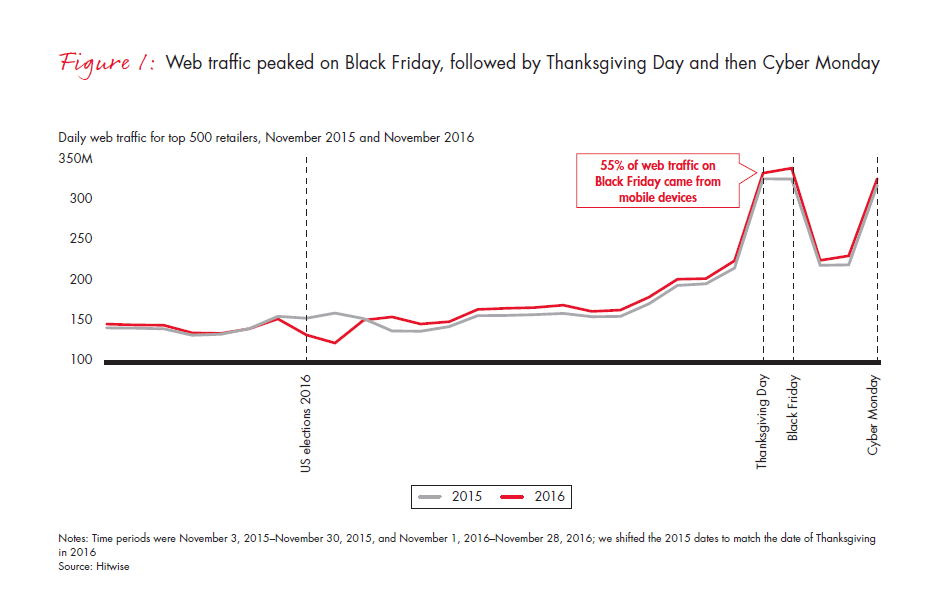
This explosion in mobile shopping makes it even more important for retailers to offer a good mobile website and app. In November we evaluated 30 top retailers’ mobile sites and apps, and found that chat, store guides and photo search are features that, when implemented effectively, differentiate the customer experience (see Figure 2).
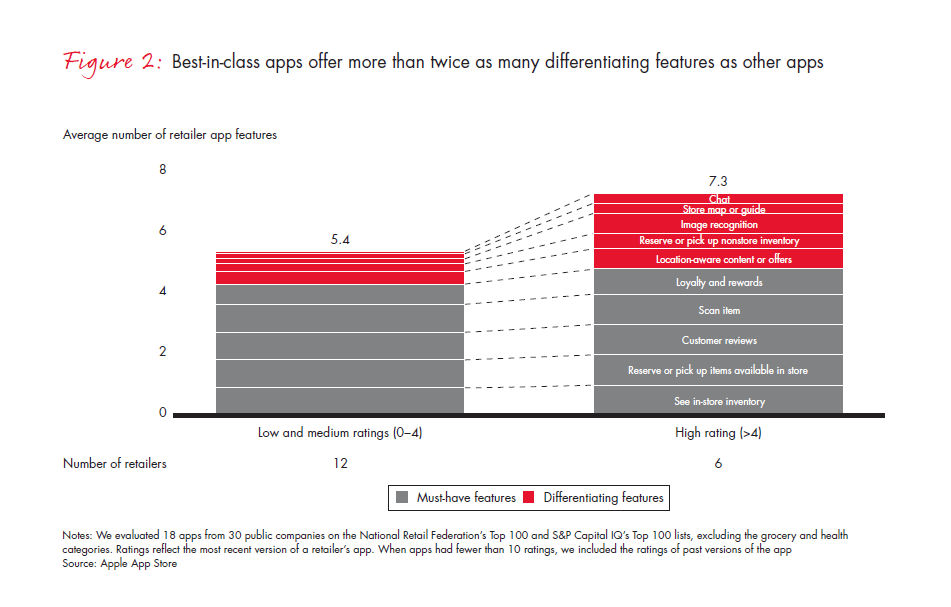
Customers also won this holiday weekend. According to a National Retail Federation survey, 36% of shoppers reported that all of their Black Friday purchases were on sale, up from 32.5% last year. We saw particularly aggressive promotions in specialty apparel, where discounts upward of 40% were common.
Since our last newsletter, we’ve continued measuring shopper satisfaction through Bain’s Shopping Experience Pulse. We surveyed 1,500 customers across the country, asking about their most recent shopping experience. Here are some of our latest findings:
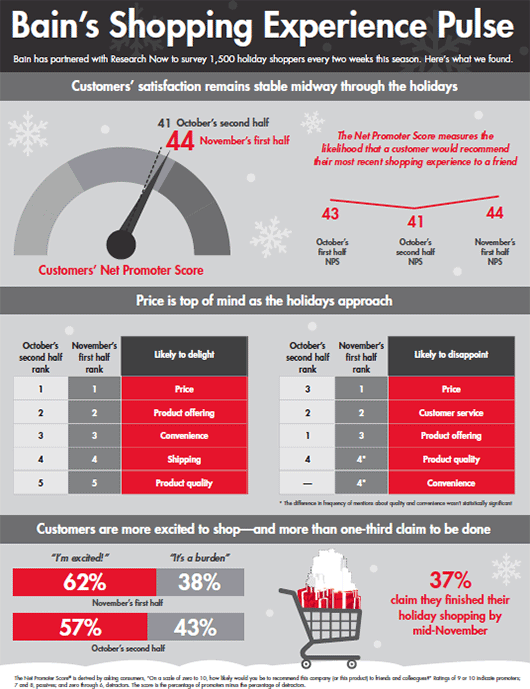
Part of the excitement about shopping for the holidays comes from the innovations retailers are introducing to create magical shopping experiences both in stores and online.
In recent weeks, heartwarming holiday ads have hit the airwaves, and clever displays have begun to brighten malls and main streets. We’ve also seen retailers debut innovations to inspire shoppers, help them find perfect gifts, make it easy to buy, receive and return items, and, of course, share their delight (see Figure 3). What follow are a few of our favorites across various parts of the customer experience.
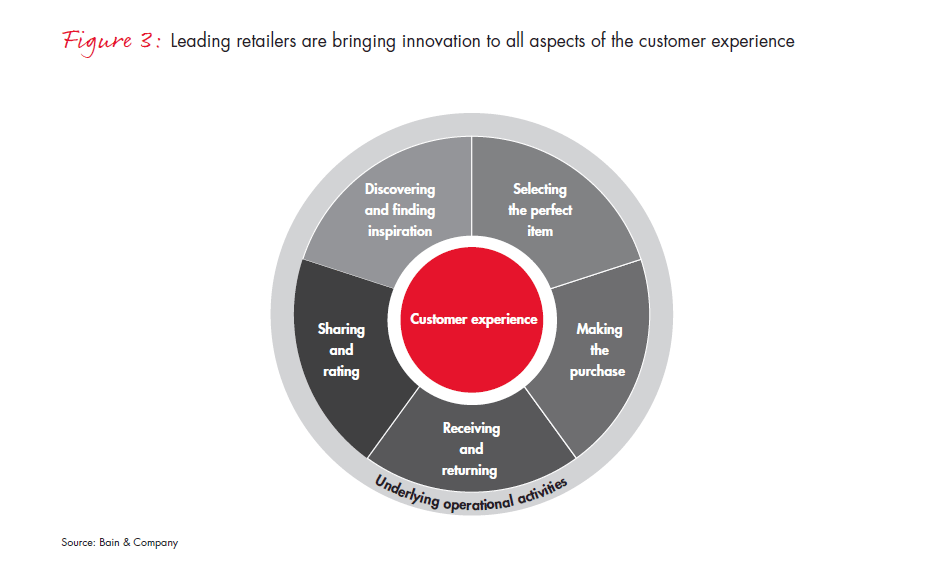
Discovering and finding inspiration
Selecting the perfect item
Making the purchase
Receiving and returning
Sharing and rating
Underlying operational activities
Lots more is happening behind the scenes. Robotics for one: Amazon deploys robotics to manage fulfillment, and other retailers are following suit. Walmart has been using robots to fill online apparel orders; and Hudson’s Bay has just upgraded its Toronto fulfillment center with a robotic system. And there’s so much more: Walmart recently implemented blockchain technology to identify and remove recalled foods. Amazon has a patent for anticipatory shipping, a system that allows the retailer to begin boxing and shipping products to customers based on their shopping cart and previous orders. Other operational activities include dynamic pricing, predictive maintenance sensors in fulfillment centers and cybersecurity.
At first glance, all of these innovations—customer facing and operational—seem worth copying. Certainly they’re not a bad place to start; but they would be a terrible place to stop. As we studied these examples in detail, we were struck by three facts:
Put simply, we’re seeing an explosion of digital innovations in retail. Those innovations are more than a boon for online retailers and a threat to traditional stores. They are powerful forces for change both in e-commerce and in physical stores.
Unfortunately the average retailer is poorly positioned to capitalize on digital trends. Gartner calculates that retailers spend just about 1.5% of sales on information technology. That’s less than half the cross- industry average of 3.4%. Furthermore, Gartner estimates that retailers’ rate of spending has actually slowed in 2016.
But the average retailer faces an even bigger challenge: E-commerce and legacy systems were often designed independently, which means they work at different speeds. E commerce operations (often based in Silicon Valley) run at high speed, while legacy systems plug away at a much slower pace.
The problem with two speeds is that inevitably the slower system holds back the faster one. Imagine Santa moving from house to house with a relatively small bag of goodies in a sleigh that moves at lightning speed. Now imagine that most of the presents Santa delivers arrive on a freight train that moves at a snail’s pace. Once Santa runs out of toys in his bag, he can’t move faster than that train.
This isn’t just a North Pole problem. Many major retailers’ websites offer shoppers the option of buying online and picking up in stores. But store systems can’t process the orders before customers get there; or they run out of stock because they batch-order inventory at the end of the day and aren’t able to dynamically allocate orders. Although stores want to improve service and reduce costs, most lack the technology that makes self-service possible, a workforce with the right tech talent, and the ability to coordinate among organizational silos. Yes, many retailers can deliver a few “goodies” on their separate system; but they can’t make the systemwide transformation needed to survive and thrive in the new world of retail.
Traditional retailers are very good at inspecting and managing the physical aspects of their business. They can see when a store is in bad shape. They can see customers lined up for blocks on Black Friday. They can see unsold inventory piling up in warehouses and back rooms. But digital assets are different. Most retail executives can’t see them, and few fully understand how digital innovations actually work.
If we could give our retail friends a gift this holiday season, we would give each of them a pair of “digital-reality” glasses, glasses that allow them to see their digital operations with the same clarity with which they see their physical operations. They would immediately recognize three problem areas:
Digital innovations come at a cost to retailers, raising questions about profitability and return on investment. When capital is limited, it can be very difficult to choose among investments. Still, despite incremental expenses, we believe it’s critical for retailers to invest in omnichannel capabilities. Omnichannel retailers win on both experience and economics. We classified 40 top retailers as omnichannel or multichannel and then assessed their performance. We found that omnichannel retailers had returns on invested capital of about 300 basis points higher than their multichannel peers (see Figure 4).
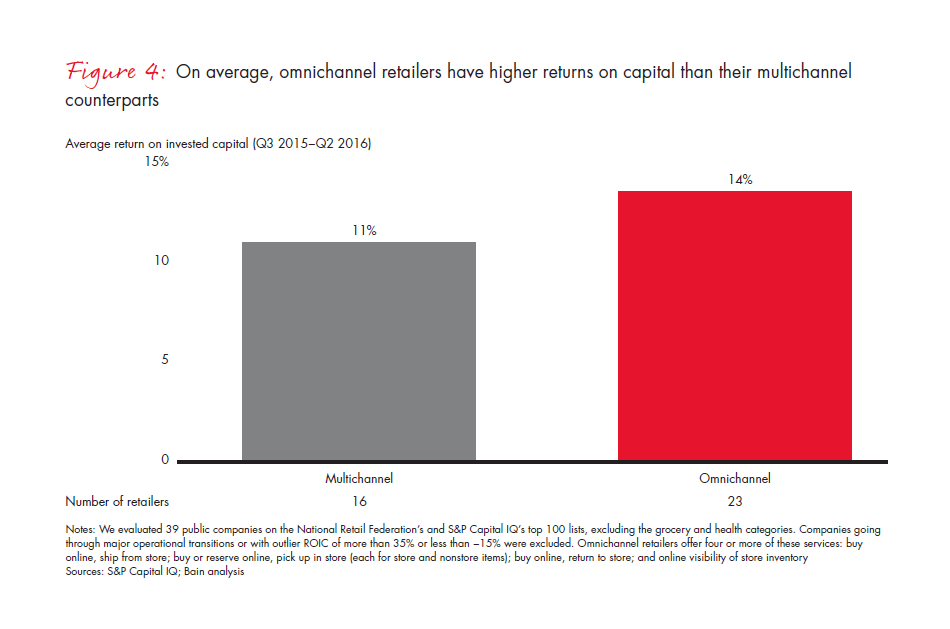
Becoming a true omnichannel retailer demands a digital transformation, and that demands the successful completion of four steps:
1. Set ambition. Define a bold ambition that fits the brand and your target customer segment.
2. Assess. Take stock of new and existing ideas across the business, both customer facing and operational, acknowledging that many of the best ideas will come from deeper in the organization.
3. Prioritize. Define those digital arenas that are most valuable, and use them as guideposts in setting priorities for current and future digital initiatives.
4. Mobilize. Most initiatives will require fundamentally new ways of working across functions and projects, using data, technology and a digital-ready team.
For more about digital innovation, see “Embracing Agile” in the May 2016 issue of Harvard Business Review and “Anatomy of a Digital Forerunner."
In our next issue we will explore the role of the store in omnichannel retail and examine how retailers are bringing the best of digital and physical shopping experiences together. We’ll also discuss the latest holiday results, including sales in November. Here’s a breakdown of the last two issues:
Please let us know if you have any questions or would like to arrange a follow-up discussion. We look forward to continuing to share news of innovations and interesting strategies with you this holiday season.
Hitwise
Hitwise, a division of Connexity, is a leading provider of online consumer insights and analytical services measuring online behavior daily to help marketers understand and reach consumers across channels in a connected device ecosystem. Hitwise unifies rich consumer attributes such as demographics, psychographics, purchase behaviors, purchase intent, media consumption and brand loyalty with granular digital consumption and search patterns across online and mobile devices. Hitwise provides large samples of online behavior in the US, UK and Australia, enabling marketers, publishers and agencies to define audience segments in real-time, buy advertising and convert more site traffic. For more information, please visit http://connexity.com/contact/.
Research Now
Research Now Group, Inc., is a global leader in digital data collection to power analytics and insights. It enables data-driven decision making for its 3,700 market research, consulting, media and corporate clients by providing access to millions of business professionals and consumers. The company has provided proprietary, research-only online panel sample since 2001 and currently operates in over 40 countries from more than 20 offices around the globe with locations in the Americas, Europe, the Middle East and Asia-Pacific. For more information, visit www.researchnow.com.
1The Net Promoter Score® is derived by asking consumers, “On a scale of zero to 10, how likely would you be to recommend this company (or this product) to friends and colleagues?” Ratings of 9 or 10 indicate promoters; 7 and 8, passives; and zero through 6, detractors. The score is simply the percentage of promoters minus the percentage of detractors. Net Promoter®, Net Promoter System®, Net Promoter Score® and NPS® are registered trademarks of Bain & Company, Inc., Fred Reichheld and Satmetrix Systems, Inc.




